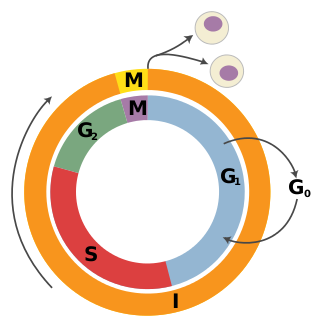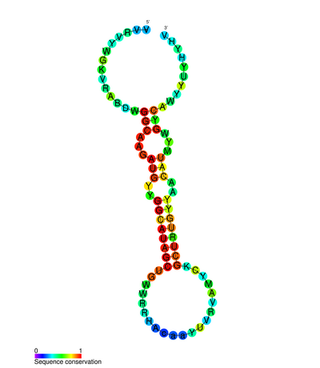Related Research Articles

A tumor suppressor gene (TSG), or anti-oncogene, is a gene that regulates a cell during cell division and replication. If the cell grows uncontrollably, it will result in cancer. When a tumor suppressor gene is mutated, it results in a loss or reduction in its function. In combination with other genetic mutations, this could allow the cell to grow abnormally. The loss of function for these genes may be even more significant in the development of human cancers, compared to the activation of oncogenes.

Metastasis is a pathogenic agent's spread from an initial or primary site to a different or secondary site within the host's body; the term is typically used when referring to metastasis by a cancerous tumor. The newly pathological sites, then, are metastases (mets). It is generally distinguished from cancer invasion, which is the direct extension and penetration by cancer cells into neighboring tissues.
Autocrine signaling is a form of cell signaling in which a cell secretes a hormone or chemical messenger that binds to autocrine receptors on that same cell, leading to changes in the cell. This can be contrasted with paracrine signaling, intracrine signaling, or classical endocrine signaling.

Maspin is a protein that in humans is encoded by the SERPINB5 gene. This protein belongs to the serpin superfamily. SERPINB5 was originally reported to function as a tumor suppressor gene in epithelial cells, suppressing the ability of cancer cells to invade and metastasize to other tissues. Furthermore, and consistent with an important biological function, Maspin knockout mice were reported to be non-viable, dying in early embryogenesis. However, a subsequent study using viral transduction as a method of gene transfer was not able to reproduce the original findings and found no role for maspin in tumour biology. Furthermore, the latter study demonstrated that maspin knockout mice are viable and display no obvious phenotype. These data are consistent with the observation that maspin is not expressed in early embryogenesis. The precise molecular function of maspin is thus currently unknown.

72 kDa type IV collagenase also known as matrix metalloproteinase-2 (MMP-2) and gelatinase A is an enzyme that in humans is encoded by the MMP2 gene. The MMP2 gene is located on chromosome 16 at position 12.2.

Ras association domain-containing protein 1 is a protein that in humans is encoded by the RASSF1 gene.

Nucleoside diphosphate kinase A is an enzyme that in humans is encoded by the NME1 gene. It is thought to be a metastasis suppressor.

Nucleoside diphosphate kinase B is an enzyme that in humans is encoded by the NME2 gene.

Deleted in Liver Cancer 1 also known as DLC1 and StAR-related lipid transfer protein 12 (STARD12) is a protein which in humans is encoded by the DLC1 gene.

Melanoma-associated antigen 4 is a protein that in humans is encoded by the MAGEA4 gene.

Breast cancer metastasis suppressor 1 is a protein that in humans is encoded by the BRMS1 gene.

Transcription factor 21 (TCF21), also known as pod-1, capsuling, or epicardin, is a protein that in humans is encoded by the TCF21 gene on chromosome 6. It is ubiquitously expressed in many tissues and cell types and highly significantly expressed in lung and placenta. TCF21 is crucial for the development of a number of cell types during embryogenesis of the heart, lung, kidney, and spleen. TCF21 is also deregulated in several types of cancers, and thus known to function as a tumor suppressor. The TCF21 gene also contains one of 27 SNPs associated with increased risk of coronary artery disease.

Epithelial membrane protein 3 (EMP3) is a trans-membrane signaling molecule that is encoded by the myelin-related gene EMP3. EMP3 is a member of the peripheral myelin protein gene family 22-kDa (PMP22), which is mainly responsible for the formation of the sheath of compact myelin. Although the detailed functions and mechanisms of EMP3 still remain unclear, it is suggested that EMP3 is possibly epigenetically linked to certain carcinomas.

Cavin-2 or Serum deprivation-response protein (SDPR) is a protein that in humans is encoded by the SDPR gene. Cavin-2 is highly expressed in a variety of human endothelial cells.

Metadherin, also known as protein LYRIC or astrocyte elevated gene-1 protein (AEG-1) is a protein that in humans is encoded by the MTDH gene.

Non-metastatic cells 4, protein expressed in, also known as NME4, is a protein which in humans is encoded by the NME4 gene.

In molecular biology miR-205 microRNA is a short RNA molecule. MicroRNAs function to regulate the expression levels of other genes by several mechanisms. They are involved in numerous cellular processes, including development, proliferation, and apoptosis. Currently, it is believed that miRNAs elicit their effect by silencing the expression of target genes.

miR-31 has been characterised as a tumour suppressor miRNA, with its levels varying in breast cancer cells according to the metastatic state of the tumour. From its typical abundance in healthy tissue is a moderate decrease in non-metastatic breast cancer cell lines, and levels are almost completely absent in mouse and human metastatic breast cancer cell lines. Mir-31-5p has also been observed upregulated in Zinc Deficient rats compared to normal in ESCC and in other types of cancers when using this animal model. There has also been observed a strong encapsulation of tumour cells expressing miR-31, as well as a reduced cell survival rate. miR-31's antimetastatic effects therefore make it a potential therapeutic target for breast cancer. However, these two papers were formally retracted by the authors in 2015.
Anticancer genes exhibit a preferential ability to kill cancer cells while leaving healthy cells unharmed. This phenomenon is achieved through various processes such as apoptosis following a mitotic catastrophe, necrosis, and autophagy. In the late 1990s, extensive research in the field of cancer cells led to the discovery of anticancer genes. Mutations in these genes due to base substitutions leading to insertions, deletions, or alterations in missense amino acids can cause frameshifts, thereby altering the protein. A change in gene copy number or rearrangements is also essential for deregulating these genes. The loss or alteration of these anticancer genes due to mutations or rearrangements may lead to the development of cancer.
References
- 1 2 3 4 Olle, David (September 9, 2009). "Metastasis Suppressors". Suite 101.
{{cite web}}: Missing or empty|url=(help)[ self-published source? ] - ↑ Gkountela, Sofia; Aceto, Nicola (2016-07-26). "Stem-like features of cancer cells on their way to metastasis". Biology Direct. 11: 33. doi: 10.1186/s13062-016-0135-4 . ISSN 1745-6150. PMC 4960876 . PMID 27457474.
- 1 2 Sobel, Mark E. (1990). "Metastasis Suppressor Genes". Journal of the National Cancer Institute. 82 (4): 267–76. doi:10.1093/jnci/82.4.267. PMID 2405170.
- 1 2 3 4 5 6 7 8 9 10 11 12 Yan, Jinchun; Yang, Qin; Huang, Qihong (2013-03-01). "Metastasis Suppressor Genes". Histology and Histopathology. 28 (3): 285–292. ISSN 0213-3911. PMC 3910084 . PMID 23348381.
- ↑ Ozturk, Sait; Papageorgis, Panagiotis; Wong, Chen Khuan; Lambert, Arthur W.; Abdolmaleky, Hamid M.; Thiagalingam, Arunthathi; Cohen, Herbert T.; Thiagalingam, Sam (2016). "SDPR functions as a metastasis suppressor in breast cancer by promoting apoptosis". Proceedings of the National Academy of Sciences. 113 (3): 638–643. Bibcode:2016PNAS..113..638O. doi: 10.1073/pnas.1514663113 . PMC 4725521 . PMID 26739564.
- ↑ Shevde, Lalita A.; Welch, Danny R. (2003). "Metastasis suppressor pathways—an evolving paradigm". Cancer Letters. 198 (1): 1–20. doi:10.1016/S0304-3835(03)00304-5. PMID 12893425.
- ↑ Jackson, Paul (2007). New Developments in Metastasis Suppressor Research. Nova Publishers. ISBN 978-1-60021-603-9.[ page needed ]
- ↑ Ozturk, Sait; Papageorgis, Panagiotis; Wong, Chen Khuan; Lambert, Arthur W.; Abdolmaleky, Hamid M.; Thiagalingam, Arunthathi; Cohen, Herbert T.; Thiagalingam, Sam (2016). "SDPR functions as a metastasis suppressor in breast cancer by promoting apoptosis". Proceedings of the National Academy of Sciences. 113 (3): 638–643. Bibcode:2016PNAS..113..638O. doi: 10.1073/pnas.1514663113 . PMC 4725521 . PMID 26739564.
- ↑ Ozturk, Sait; Papageorgis, Panagiotis; Wong, Chen Khuan; Lambert, Arthur W.; Abdolmaleky, Hamid M.; Thiagalingam, Arunthathi; Cohen, Herbert T.; Thiagalingam, Sam (2016). "SDPR functions as a metastasis suppressor in breast cancer by promoting apoptosis". Proceedings of the National Academy of Sciences. 113 (3): 638–643. Bibcode:2016PNAS..113..638O. doi: 10.1073/pnas.1514663113 . PMC 4725521 . PMID 26739564.
- ↑ Chong, L. D. (2016). "Suppressing cancer spread". Science. 351 (6271): 351–352. Bibcode:2016Sci...351R.351C. doi: 10.1126/science.351.6271.351-g .
- ↑ Kauffman, Eric C.; Robinson, Victoria L.; Stadler, Walter M.; Sokoloff, Mitchell H.; Rinker-Schaeffer, Carrie W. (2003). "Metastasis Suppression: The Evolving Role of Metastasis Suppressor Genes for Regulating Cancer Cell Growth at the Secondary Site". The Journal of Urology. 169 (3): 1122–33. doi:10.1097/01.ju.0000051580.89109.4b. PMID 12576866.
- ↑ Yoshida, Barbara A.; Sokoloff, Mitchell M.; Welch, Danny R.; Rinker-Schaeffer, Carrie W. (2000). "Metastasis-Suppressor Genes: a Review and Perspective on an Emerging Field". Journal of the National Cancer Institute. 92 (21): 1717–30. doi: 10.1093/jnci/92.21.1717 . PMID 11058615.